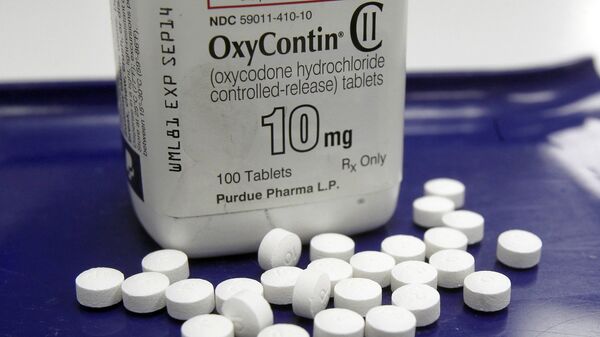The state lawyers claim that Johnson & Johnson, along with pharmaceutical giant Purdue Pharma, which produces prescription painkiller OxyContin, and Teva Pharmaceutical Industries, used misleading marketing starting back in the 1990s and pushed doctors to prescribe more opioids.
The National Institute on Drug Abuse [NIDA] says that in the United States more than 130 people die daily after overdosing on opioids. Also, it notes that this includes prescription pain killers that people misuse and get addicted to and synthetic opioids like fentanyl. Meanwhile, the Centers for Disease Control and Prevention estimates there was a record 47,600 opioid-related overdose deaths in 2017.
READ MORE: Melania Trump Urges MSM to Ditch 'Idle Gossip' for Coverage of Opioid Epidemic
American Addiction Centers’ Chief Medical Officer Dr Lawrence Weinstein said that the most frequently prescribed opioid in the United States is hydrocodone, but all opioids pose a risk if not taken the right way, with the most dangerous being “fentanyl, or any of its analogues, which is the synthetic opioid behind a number of overdoses and overdose deaths. Different opioids work at a much quicker rate than others.
“Some forms of fentanyl are 100 times stronger than morphine and up to 15 times more potent than heroin,” the doctor stressed.
The Oklahoma trial is the first of more than 1,600 plus lawsuits filed by US governmental bodies against pharmaceutical giant Johnson & Johnson. The company is accused of being behind “the worst man-made public health crisis in the state's history.”
“They, first of all, say as far as the claim of fraudulent marketing, that this was an exercise of free speech, that this was their honest opinion, and the opinion of others, and there was nothing wrong with that. They also make an argument that in so far as they're accused of not fully disclosing the risks of the use of opioids for long-term treatment of chronic pain, that the FDA approved the labelling and therefore the court can’t say that the labelling was inadequate, that those kinds of claims are pre-emptive,” the law professor noted.
Oklahoma settled cases against Purdue Pharma, which produces OxyContin, in March for $270 million and against Teva Pharmaceutical Industries last month for $85 million. But as Richard C. Ausness noted, they believe they have a very strong case as J&J only accounted for less than 1% of the market, so they can't be blamed for the entire opioid crisis:
“The drugs that they actually sold were fentanyl patches and other kinds of drugs that really weren’t anything like the ones that Purdue Pharma sold that were pills that could easily be crushed and therefore abused, and also they were only in the market for a very short time, and had not been selling drugs for quite some time,” Ausness said.
“It’s concerned with injuries to real property or activities that occur in real property and that’s simply not what happened here, and I think that’s a good argument, that argument was made in other cases involving handguns and tobacco, and that argument was pretty persuasive.”
READ MORE: Trump Gets Flack for Spending Opioids Speech Talking About Dogs, Melania's Dress
Dr Weinstein went on to explain how the body reacts to taking opioids and what causes the addiction:
“Opioids work in the brain and central nervous system by activating receptors that cause euphoria and reduce pain. At the same time, opioids also activate receptors that depress breathing. This is where the potential of overdose lies. Over time, an individual will build up a tolerance, meaning that they will need more and more of the drug to achieve the same effect. By taking too strong of a dose, the drug can depress an individual’s breathing to the point that it stops,” he explained, adding that most chronic pain patients “use their medication as prescribed and less than 10% of those patients become addicted.”
READ MORE: Anti-Drug White House Still Allowing Breakthrough Psychedelic Research
“Often, opioid use is symptomatic of a greater mental health issue, and addressing the underlying cause is key. Advanced technology that can expand access to mental health care is also important. Some of the areas most affected by the opioid crisis do not have the proper resources to address the issue. Another measure, and an integral one at that, is investment into extensive research of the disease of addiction.”
Various reports show there's a direct link between lobbying for opioid medicines and an increasing epidemic of opioid drug usage. According to statistics from the National Institute of Drug Abuse, opioid-drug overdose deaths rose from 8,048 in 1999 to 47,600 in 2017. Michael Cartwright the CEO of American Addiction Centers said that pharmaceutical companies play a big role in the level of opioid addiction:
“It’s time for drug makers to own up to their part in contributing to the opioid crisis. They are doing a poor job of providing answers to the disease of addiction, and this trial in Oklahoma could be the first step in legally holding them accountable. Pharmaceutical companies need to recognize their wrong doings and offer funding and solutions to this crisis they helped create,” Cartwright stated.
The trail in Oklahoma is expected to last for 2 months.
The views and opinions expressed by the speakers do not necessarily reflect those of Sputnik.






